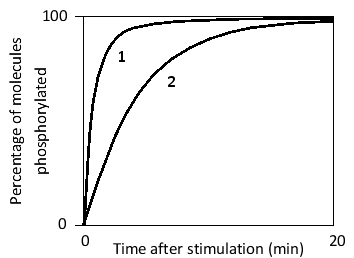Question 17
(Short Answer)
Consider a signaling protein that can be phosphorylated by a dual-specificity protein kinase at two independent sites (one tyrosine and one serine residue), such that each site is phosphorylated in about 1% of the protein molecules under normal conditions. Phosphorylation at the first site has a short half-life, since a fast tyrosine phosphatase removes the phosphate soon after the residue is phosphorylated, whereas dephosphorylation at the second site-carried out by a serine/threonine phosphatase-is relatively slow. Upon activation of a signaling pathway, the concentration of the dual-specificity kinase increases several-fold rapidly. The phosphorylation state of the tyrosine and serine residues following stimulation is compared in the following graph. Which curve (1 or 2) do you think corresponds to the serine residue? Write down 1 or 2 as your answer.

Answer
In this example, the slower dephosphory...
View full Answer